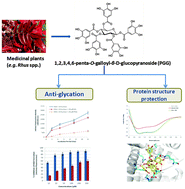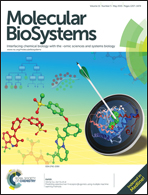The hydrolyzable gallotannin, penta-O-galloyl-β-d-glucopyranoside, inhibits the formation of advanced glycation endproducts by protecting protein structure
Abstract
Glycation is a spontaneous process initiated by a condensation reaction between reducing sugars and proteins that leads to the formation of advanced glycation endproducts (AGEs). The in vivo accumulation of AGEs is associated with several chronic human diseases and, thus, the search for AGE inhibitors is of great research interest. Hydrolyzable tannins (gallotannins and ellagitannins) are bioactive plant polyphenols which show promise as natural inhibitors of glycation and AGE formation. Notably, the gallotannin, 1,2,3,4,6-penta-O-galloyl-β-D-glucose (PGG), is a key intermediate involved in the biosynthesis of hydrolyzable tannins in plants. Herein, we investigated the effects of PGG on the individual stages of protein glycation and on protein structure (using bovine serum albumin; BSA). MALDI-TOF data demonstrated that PGG inhibited early glycation by 75% while the synthetic AGE inhibitor, aminoguanidine (AG), was not active (both at 50 μM). In addition, PGG reduced the formation of middle and late stage AGEs by 90.1 and 60.5%, respectively, which was superior to the positive control, AG. While glycation induced conformational changes in BSA from α-helix to β-sheets (from circular dichroism and congo red binding studies), PGG (at 50 μM) reduced this transition by 50%. Moreover, BSA treated with PGG was more stable in its structure and retained its biophysical properties (based on zeta potential and electrophoretic mobility measurements). The interaction between PGG and BSA was further supported by molecular docking studies. Overall, the current study adds to the growing body of data supporting the anti-AGE effects of hydrolyzable tannins, a ubiquitous class of bioactive plant polyphenols.

- This article is part of the themed collection: Chemical Biology in Molecular BioSystems

 Please wait while we load your content...
Please wait while we load your content...